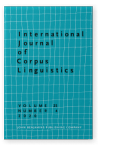Vol. 25:4 (2020) ► pp.369–399
Keyword analysis and the indexing of Aboriginal and Torres Strait Islander identity
A corpus linguistic analysis of the Australian Indigenous TV drama Redfern Now
This article presents a corpus-driven sociolinguistic study of Redfern Now – the first major television drama series commissioned, written, acted, directed and produced by Indigenous industry professionals in Australia. The study examines whether corpus linguistic keyword analysis can identify evidence for type indexicality (social demographics, personae) and trait indexicality (stance, personality), with particular attention paid to the potential indexing of Aboriginal and Torres Strait Islander identity. More specifically, the study’s goal is to retrieve and analyse words that are associated with varieties of English in Australia, and with Australian Aboriginal Englishes in particular. To this end, a corpus with dialogue from Redfern Now is compared to a reference corpus of US television dialogue. Results show that Redfern Now features the use of easily recognisable and familiar words (e.g. blackfella[s], deadly; kinship terms), but also shows clear variation among characters. The case study concludes by evaluating the use of keyword analysis for identifying indexicality in telecinematic discourse.
Article outline
- 1.Introduction
- 2.Aboriginal and minority Englishes
- 2.1Australian Aboriginal English(es)
- 2.2Minority Englishes and telecinematic discourse
- 3.Methodology
- 3.1Data
- 3.2Methods
- 4.Analysis
- 4.1Range
- 4.2Australian English/Culture
- 4.3Aboriginal ways of using English
- 4.4Kinship terms
- 5.Conclusions
- Language note
- Acknowledgements
- Notes
-
References
